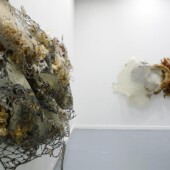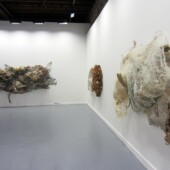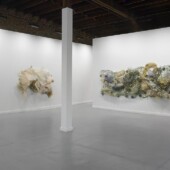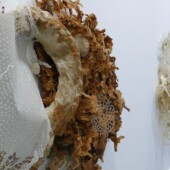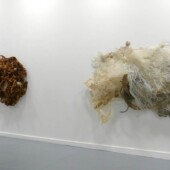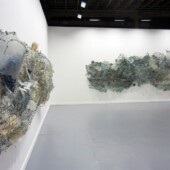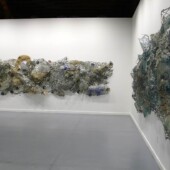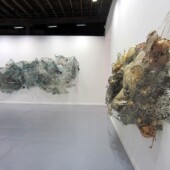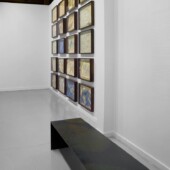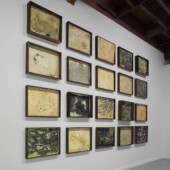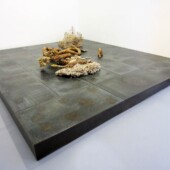Marginal Waters
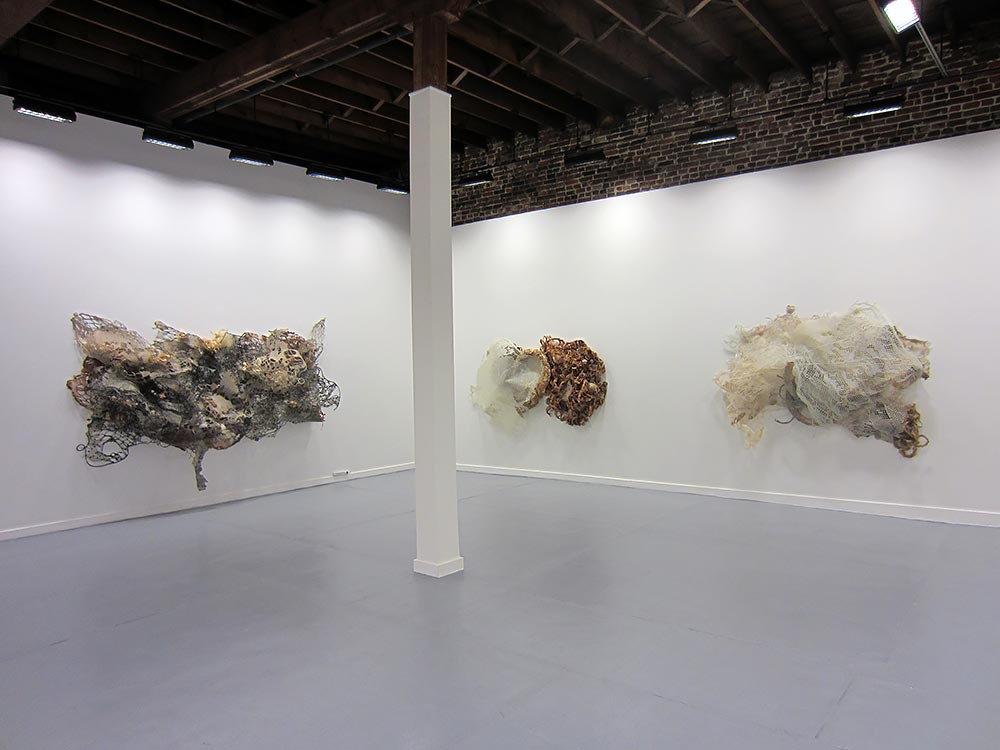
MARGINAL WATERS
September 7 – October 13, 2012
BRUNO DAVID GALLERY
JOAN HALL: HOME FROM THE SEA
by Buzz Spector
That Joan Hall is a sailor as well as an artist and educator is well known to her friends and increasingly global public. Time she spends in her studio, itself redolent of the wavelets and wafting that papermaking has in common with oceans, happens between adventur- ing in a more nautical sense. I’ve spent some time in Hall’s studio, lifting pulp-laden screens with her from one or another of several tubs, and the gentle slosh of “couching” sheets is a rhythmic and momentary evocation of a private ocean. All paper achieves its mature dryness from a wet birth of pulp in water, but few artist/papermakers are as devoted to carrying the affective memory of the “bounding main” into their finished work.
“Marginal Waters,” Hall’s installation at Bruno David Gallery, is a voyage of sorts, bringing viewers to a greater understanding of the artist’s material and existential interests as they move through the gallery’s three successive spaces. In so doing they are confronted by symbolic—and occasionally literal—accoutrements of sailing the high seas. The journey begins, so to speak, with the “boat deck” of Hello Sailor, a 12 x 14-foot plinth of steel plates, subtly sloping toward one wall of the front gallery. This tilt references the eternal listing of any vessel plying open waters, while the clusters of etched designs on its surface turn out to be, on closer inspection, a repertoire of sailors’ tattoos. Among the drawings of anchors, mermaids, and coiled ropes we read the names of the three boats that Hall has owned, “Cygnet,” “Tangerine,” and “Havsflickan,” a Swedish sobriquet roughly translated as “Sea Girl.” This deck, with its tattoo imagery, holds an arrangement of actual sea-related found objects up to view: short sections of hawsers and a dilapidated crab pot, each encased in handmade paper husks. There is a melancholic undertone to this display, since every “found” object must first be “lost,” and Hall acknowledges this attitude by labeling as “detritus” the artifacts she’s chosen.
Things look up in the next space, the main gallery—in more sense than one as named here—in the encounter with five large wall- mounted works in/of paper, cut pieces of mylar netting, and nestled found objects. These “nets” seem to float out from the walls, encouraging viewers to draw closer to see the images and objects suspended in their material layerings, then farther away in order to grasp their shared quality of unboundedness, a collective spatial effect more in common with sailing than drifting. This distinction is key to the artist’s ultimate optimism about life; being adrift is a sailor’s nightmare but, if there is no argument to win against the sea, all of sailing is at least a negotiation with its vastness on behalf of destinations to be reached, goals to be achieved.
Hall’s palette in this suite—greens and blues shot through with moments of rust and gray—offers color as a rhetorical armature for another of her concerns; the increasing pollution of the world’s oceans. Pollution of another sort, bodily disease, is recorded in the images of cancer cells on numerous disk-shaped pieces of film mounted in several of the wall works. The comparison Hall makes between the dirtying of open water and infections inside bodies arises from the fundamental corporeal equivalence of salt in our blood to the salinity of ancient oceans. It bears mention that Hall is a cancer survivor as well as a sailor who has always returned home from the sea.
Those little disks of film also foreshadow the banks of framed paper and artifacts in the furthermost gallery; facing arrays of twenty steel-framed handmade paper and mixed-media sheets, these often accompanied by small bits of cast paper flotsam and jetsam. Johnson’s Bayou is five rows high and four across; Grand Isle is four rows high and five across. Forty “specimen boxes” in all, whose constituent elements are made using material harvested from a titular pair of Louisiana beaches along the Gulf of Mexico. The bits of plastic visible in the Johnson’s Bayou works speak to increasing ocean pollution while the blackness staining some of the Grand Isle works calls our attention to the damage suffered by that beach in the BP oil spill. The third work in the space is Rigs to Reef, a freestanding steel bench whose seat is etched with a drawing of branch coral. The bench is also equipped with motion sensors that turn on a sound generating mechanism whenever someone comes near. The soundtrack thus activated is a field recording of the sound of waves (and a touch of Cajun music) mixed with an original violin score written and performed by Hall’s friend, the com- poser Hollis Taylor.
On the closest wall to the bench is a near-invisible text, in white vinyl on the white gallery wall, describing the political and method- ological bases of Hall’s Gulf project. Squinting to read the words on the wall we realize that the bench’s title makes reference to the ecosensitive practice of allowing no longer functioning deep water oil rigs to remain in place as environments for naturally growing ocean reefs. Rigs to Reef is another optimistic moment in “Marginal Waters,” its audio component incorporating a human overlay to the beautiful natural music of the waves. However, the sound of Taylor’s violin is itself something beautiful, a tonal entwining of artistic agency with a natural affect. Here, but only for those who approach it, can be found a summary of Hall’s deeply held belief in our capacity to save the Earth’s waters from the margins of environmental disaster. If, in its entirety, “Marginal Waters” operates as a polemic, its argument is made all the more beguiling through its beauty.
